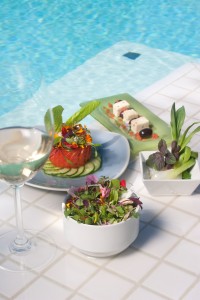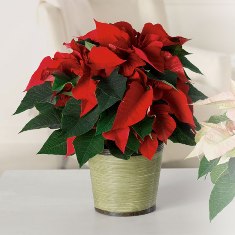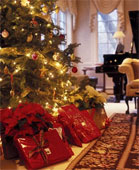 I know you are reading this thinking, “I thought flowers were only to be looked at and enjoyed visually!” Not true. In fact, you can eat them too. And for the most part edible flowers are low in (or free of) calories, cholesterol and fat. Edible flowers have been used as food for thousands of years. And although I have been unable to find much documentation about the nutritional benefits of flowers as food, it seems to me if the animal planet has eaten flowers since the dawn of time, then they must be healthy. And I imagine being on an Edible Flower Diet you could loose weight fast. Not to mention that edible flower diet is exotic eating at it’s finest.
I know you are reading this thinking, “I thought flowers were only to be looked at and enjoyed visually!” Not true. In fact, you can eat them too. And for the most part edible flowers are low in (or free of) calories, cholesterol and fat. Edible flowers have been used as food for thousands of years. And although I have been unable to find much documentation about the nutritional benefits of flowers as food, it seems to me if the animal planet has eaten flowers since the dawn of time, then they must be healthy. And I imagine being on an Edible Flower Diet you could loose weight fast. Not to mention that edible flower diet is exotic eating at it’s finest.
Of course there are some precautions you should take when considering the edible flower diet. First and foremost, not every flower is edible. About.com has a great chart of poisonous and non-edible flowers you should stay away from.
You can also check out this List of Edible Flowers at Eden Florist. Many Edible flowers can be found at gourmet grocery stores and local farmer’s markets.
In addition to those on the chart, the greens of dandelions are edible but they don’t taste good. Many edible flowers add little or no flavor to recipes, they just look pretty.
You can use edible flowers in infused vinegars, candies, sorbets, syrups, jellies and jams, as marinades, drinks, wines, meats, flower butter, dips and spreads, soups and as garnish to add color to the presentation. They can be added to water and frozen to create pretty ice cubes and add a dash of flavor to drinks. Place a colorful gladiolus floret (after removing the stamen and pistil) in a clear glass bowl and fill with your favorite jam, spread or dip.
Here are two low-fat recipes to add to your edible flower diet recipe box (also great for entertaining):
Hollyhock or Nasturtium Hors d’oevres
3 dozen hollyhock, daylily or nasturtium blossoms – washed and drained
1 jar (5 ounces) low fat cream cheese and pineapple spread
¼ cup low fat whipped cream cheese with chives
¼ cup turkey, chicken or tuna salad
With a small spoon carefully stuff each blossom with a small amount of one of the three fillings.
Line platter with nasturtium leaves and arrange filled blossoms. Refrigerate for 30 minutes. Serve chilled
Turkey Calendula Wraps
8 ounces fat-free cream cheese, softened
2 tablespoons low fat or fat free mayonnaise
1-tablespoon horseradish
2-3 teaspoons lemon juice
2 tablespoons diced sweet pickle relish
1 tart apple, peeled cored and finely diced
1-cup calendula or marigold petals
4 twelve-inch low-fat tortillas
8 ounces turkey thinly sliced
Garnish with Lettuce and marigold petals
In a bowl blend the cream cheese with mayonnaise, horseradish, lemon juice and pickle relish. Gently stir in apple and flower petals. With a spatula spread the mixture evenly over each tortilla. Cover spread with a single layer of turkey or ham. Roll filled tortilla, jellyroll style. Wrap tightly in plastic wrap- chill for 20 minutes or more. To serve, cut to desired thickness and arrange on a serving platter over a bed of lettuce. Sprinkle with additional flower petal garnish.
Be sure to use flowers sparingly in your recipes. Some people experience digestion problems when consuming flowers for the first time. The best thing to do is start small and see if you have a reaction before plunging into the edible flower diet.
Happy Dieting!



 The Candy Cane
The Candy Cane

 The Christmas Tree originated in Germany in the 16th century. It was common for the Germanic people to decorate fir trees, both inside and out, with roses, apples, and colored paper. It is believed that Martin Luther, the Protestant reformer, was the first to light a Christmas tree with candles. While coming home one dark winter’s night near Christmas, he was struck with the beauty of the starlight shining through the branches of a small fir tree outside his home. He duplicated the starlight by using candles attached to the branches of his indoor Christmas tree. The Christmas tree was not widely used in Britain until the 19th century. It was brought to America by the Pennsylvania Germans in the 1820’s.
The Christmas Tree originated in Germany in the 16th century. It was common for the Germanic people to decorate fir trees, both inside and out, with roses, apples, and colored paper. It is believed that Martin Luther, the Protestant reformer, was the first to light a Christmas tree with candles. While coming home one dark winter’s night near Christmas, he was struck with the beauty of the starlight shining through the branches of a small fir tree outside his home. He duplicated the starlight by using candles attached to the branches of his indoor Christmas tree. The Christmas tree was not widely used in Britain until the 19th century. It was brought to America by the Pennsylvania Germans in the 1820’s.